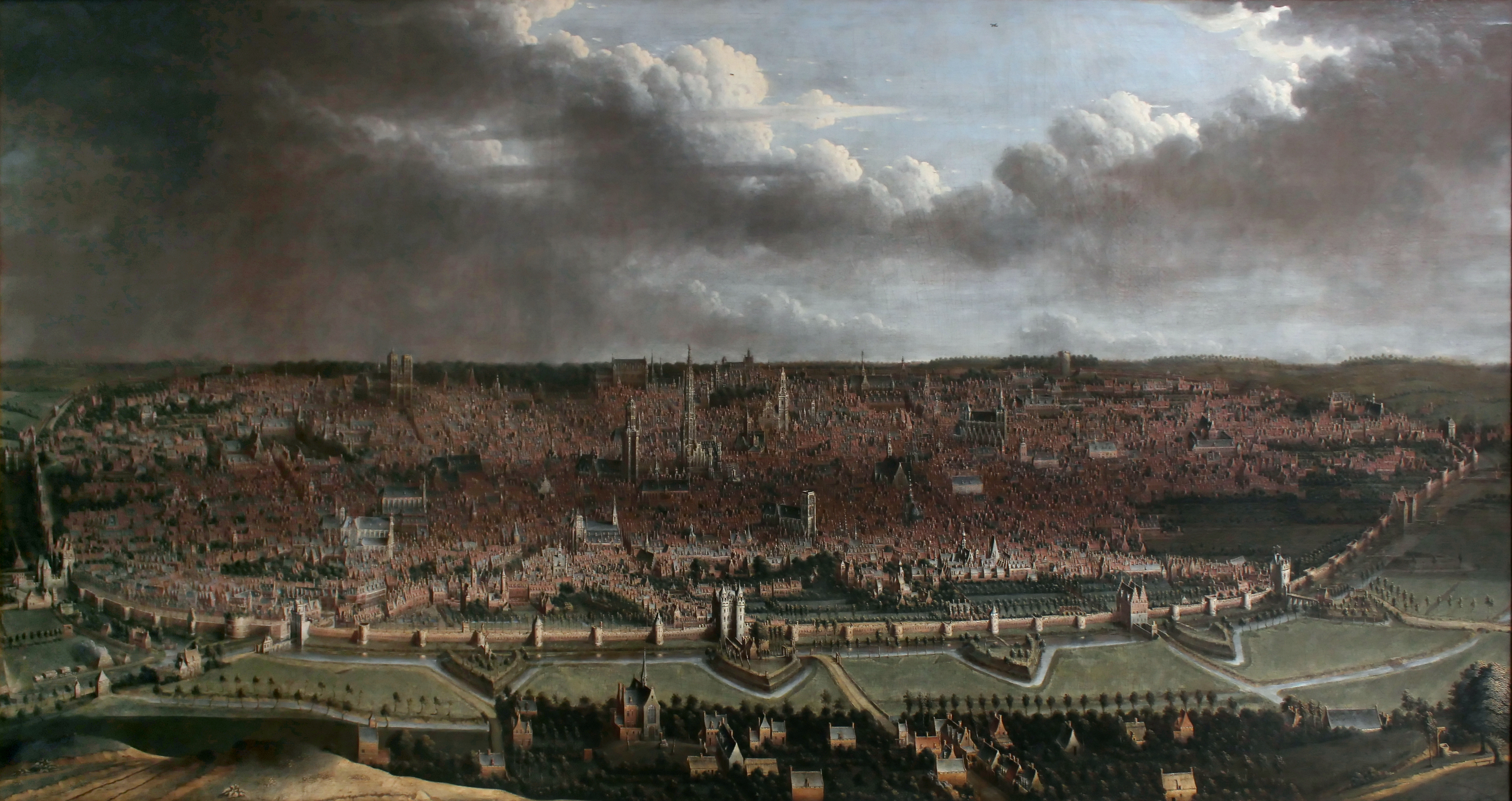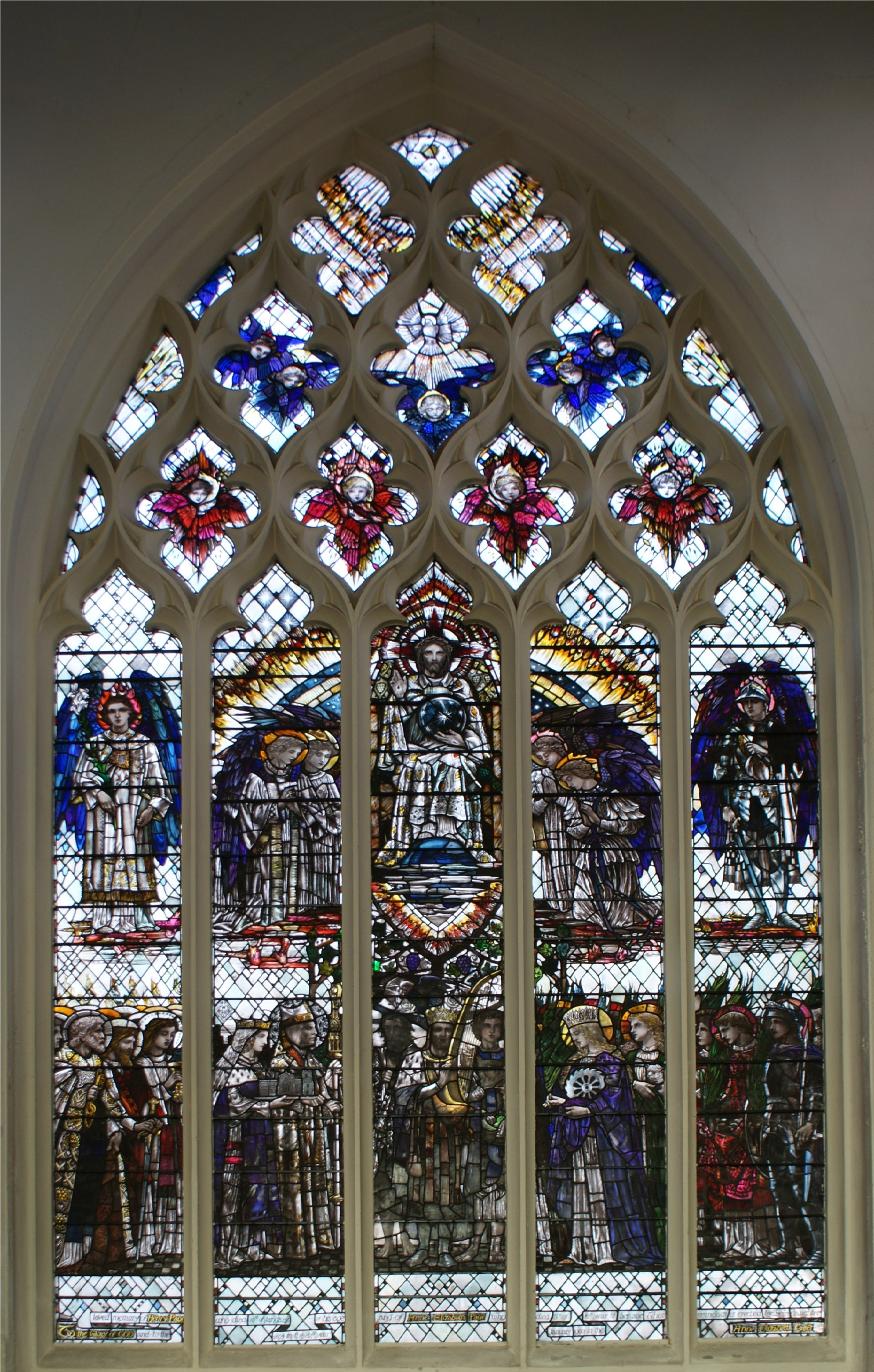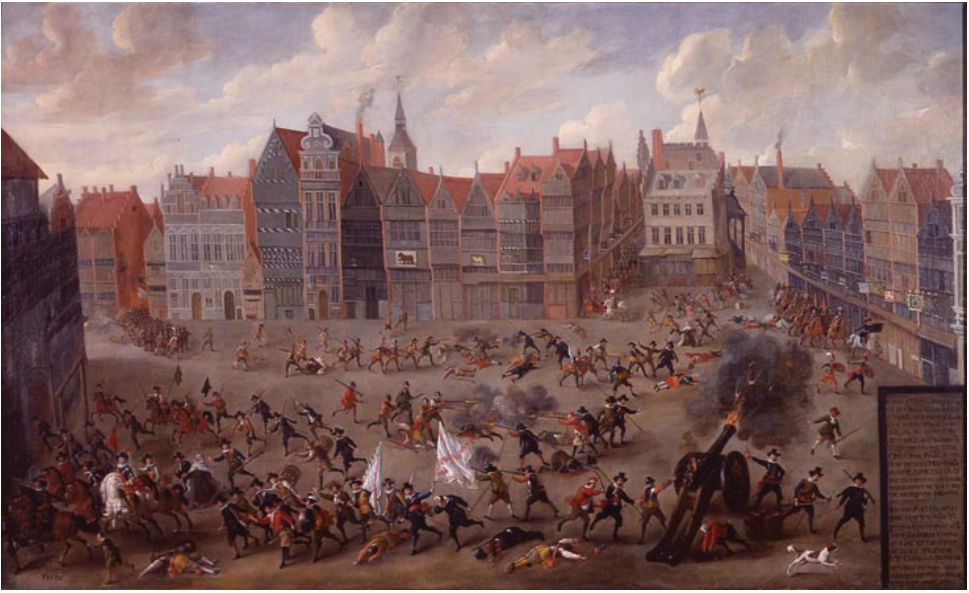|
St. Michael And Gudula Cathedral
The Cathedral of St. Michael and St. Gudula (; ), usually shortened to the Cathedral of St. Gudula or St. Gudula by locals, is a medieval Catholic cathedral in central Brussels, Belgium. It is dedicated to Saint Michael and Saint Gudula, the patron saints of the City of Brussels, and is considered to be one of the finest examples of Brabantine Gothic architecture. The Romanesque church's construction began in the 11th century, replacing an earlier chapel, and was largely complete in its current Gothic form by the 16th, though its interior was frequently modified in the following centuries. The building includes late-Gothic and Baroque chapels, whilst its neo-Gothic decorative elements, including some of its stained glass windows in the aisles, date from restoration work in the 19th century. St. Gudula also stands out for its musical components, notably its two pipe organs and its immense church bells. The complex was designated a historic monument in 1936. The church was ele ... [...More Info...] [...Related Items...] OR: [Wikipedia] [Google] [Baidu] |
City Of Brussels
The City of Brussels is the largest List of municipalities of the Brussels-Capital Region, municipality and historical City centre, centre of the Brussels, Brussels-Capital Region, as well as the capital of the French Community of Belgium, the Flemish Region (from which it is List of capitals outside the territories they serve, separate) and Belgium. The City of Brussels is also the administrative centre of the European Union, as it hosts a number of principal Institutions of the European Union, EU institutions in its Brussels and the European Union#European Quarter, European Quarter. Besides the central historic town located within the Pentagon (Brussels), Pentagon, the City of Brussels covers some of the city's immediate outskirts within the greater Brussels-Capital Region, namely the former municipalities of Haren, Belgium, Haren, Laeken, and Neder-Over-Heembeek to the north, as well as the Avenue Louise, Avenue Louise/Louizalaan and the Bois de la Cambre, Bois de la Cambre/ ... [...More Info...] [...Related Items...] OR: [Wikipedia] [Google] [Baidu] |
Baroque
The Baroque ( , , ) is a Western Style (visual arts), style of Baroque architecture, architecture, Baroque music, music, Baroque dance, dance, Baroque painting, painting, Baroque sculpture, sculpture, poetry, and other arts that flourished from the early 17th century until the 1750s. It followed Renaissance art and Mannerism and preceded the Rococo (in the past often referred to as "late Baroque") and Neoclassicism, Neoclassical styles. It was encouraged by the Catholic Church as a means to counter the simplicity and austerity of Protestant architecture, art, and music, though Lutheran art#Baroque period, Lutheran Baroque art developed in parts of Europe as well. The Baroque style used contrast, movement, exuberant detail, deep color, grandeur, and surprise to achieve a sense of awe. The style began at the start of the 17th century in Rome, then spread rapidly to the rest of Italy, France, Spain, and Portugal, then to Austria, southern Germany, Poland and Russia. By the 1730s, i ... [...More Info...] [...Related Items...] OR: [Wikipedia] [Google] [Baidu] |
Parc Metro Station (Brussels)
(French language, French, ) or (Dutch language, Dutch, ) is a Brussels Metro List of Brussels metro and premetro stations, station on lines Brussels Metro line 1, 1 and Brussels Metro line 5, 5. It is located under Brussels Park in central Brussels, Belgium. It has one entrance, at the intersection of the Rue Royale, Brussels, Rue Royale/Koningsstraat and the Rue de la Loi, Rue de la Loi/Wetstraat, two of the main roads of the City of Brussels. The station opened on 17 December 1969 as a ''Trams in Brussels, premetro'' (underground tram) station on the tram line between De Brouckère station, De Brouckère and Schuman station, Schuman. This station was upgraded to full rapid transit, metro status on 20 September 1976, serving former east–west line 1 (further split in 1982 into former lines 1A and 1B). Then, following the reorganisation of the Brussels Metro on 4 April 2009, it now lies on the joint section of east–west lines 1 and 5. History / station was inaugurated on 1 ... [...More Info...] [...Related Items...] OR: [Wikipedia] [Google] [Baidu] |
Brussels-Central Railway Station
Brussels-Central railway station (; ) is a railway and metro station in central Brussels, Belgium. It is the second busiest railway station in Belgium and one of three principal railway stations in Brussels, together with Brussels-South and Brussels-North. First completed in 1952 after protracted delays caused by economic difficulties and World War II, it is the newest of Brussels' main rail hubs. The train services are operated by the National Railway Company of Belgium (SNCB/NMBS). Brussels-Central is connected to the rapid transit Gare Centrale/Centraal Station station on lines 1 and 5 of the Brussels Metro system, and serves as an important node of the Brussels Intercommunal Transport Company ( STIB/MIVB). History Inception and construction During the late 19th and early 20th centuries, Brussels-North and Brussels-South were the primary railway stations in Brussels (Brussels-North slowly supplanted the original / railway station near the same site). However, the ... [...More Info...] [...Related Items...] OR: [Wikipedia] [Google] [Baidu] |
North–South Connection
The North–South connection (; ) is a railway link of national and international importance through central Brussels, Belgium, that connects the major railway stations in the city. It is line 0 (zero) of the Belgian rail network. With 1200 trains a day, it is the busiest railway line in Belgium and the busiest railway tunnel in the world. It has six tracks and is used for passenger trains, or rarely for a maintenance train when work is to be done on the railway infrastructure inside the North–South connection itself, but not for freight trains. It is partially underground (around Brussels-Central railway station) and partially raised above street level. History During the late 19th and early 20th centuries, Brussels was served by two main railway stations: Brussels-North (opened in 1846) and Brussels-South (opened in 1869, replacing a nearby station of 1840). They are located just outside opposite ends of the Pentagon—an area within the ring roads which follow the bou ... [...More Info...] [...Related Items...] OR: [Wikipedia] [Google] [Baidu] |
Belgian National Day
Belgian National Day (; ; ) is the national holiday of Belgium commemorated annually on 21 July. It is one of the country's ten public holidays and marks the anniversary of the investiture of Leopold I as the first King of the Belgians in 1831. History In the aftermath of the Napoleonic Wars, Belgium became part of the United Netherlands. After a period of growing unrest, the Belgian Revolution forced Dutch forces out of the country between August and October 1830. By November, the different revolutionary factions had coalesced around the idea of national independence and began drafting a constitution for an independent Belgian state. It was decided that it would become a constitutional and popular monarchy, reflecting the romantic nationalism popular at the time. Searching for a monarch, the revolutionaries decided on Prince Leopold of Saxe-Coburg-Gotha who was a German aristocrat popular in the United Kingdom. Leopold arrived in Brussels in early July 1831 and, on 21 Jul ... [...More Info...] [...Related Items...] OR: [Wikipedia] [Google] [Baidu] |
Te Deum
The ( or , ; from its incipit, ) is a Latin Christian hymn traditionally ascribed to a date before AD 500, but perhaps with antecedents that place it much earlier. It is central to the Ambrosian hymnal, which spread throughout the Latin Church with other parts of the Ambrosian Rite of Milan in the 6th to 8th centuries. It is sometimes known as the Ambrosian Hymn, although authorship by Saint Ambrose is unlikely. The term can also refer to a short religious service (of blessing or thanks) that is based upon the hymn. It continues in use in many contexts by several denominations. In particular it is the core of a short church service of thanksgiving held, often at short notice, to celebrate good news such as a military victory, the signing of a peace treaty, or the birth of a royal child. History Authorship of the hymn is traditionally ascribed to Saint Ambrose (died 397) or Saint Augustine (died 430). In 19th-century scholarship, Saint Hilary of Poitiers (died 367) ... [...More Info...] [...Related Items...] OR: [Wikipedia] [Google] [Baidu] |
Bishops In The Catholic Church
In the Catholic Church, a bishop is an ordained minister who holds the fullness of the sacrament of holy orders and is responsible for teaching doctrine, governing Catholics in his jurisdiction, sanctifying the world and representing the church. Catholics trace the origins of the office of bishop to the apostles, who it is believed were endowed with a special charism and office by the Holy Spirit at Pentecost. Catholics believe this special charism and office has been transmitted through an unbroken succession of bishops by the laying on of hands in the sacrament of holy orders. Diocesan bishops—known as eparchial bishops in the Eastern Catholic Churches—are assigned to govern local regions within the Catholic Church known as dioceses in the Latin Church and eparchies in the Eastern Churches. Bishops are collectively known as the College of Bishops and can hold such additional titles as archbishop, cardinal, patriarch, or pope. As of 2020, there were approximately ... [...More Info...] [...Related Items...] OR: [Wikipedia] [Google] [Baidu] |
Mechelen
Mechelen (; ; historically known as ''Mechlin'' in EnglishMechelen has been known in English as ''Mechlin'', from where the adjective ''Mechlinian'' is derived. This name may still be used, especially in a traditional or historical context. The city's French name, ', had also been used in English in the past (in the 19th and 20th centuries); however, this has largely been abandoned. Meanwhile, the Dutch-derived ' began to be used in English increasingly from the late 20th century onwards, even while ''Mechlin'' remained still in use (for example, a ''Mechlinian'' is an inhabitant of this city or someone seen as born-and-raised there; the term is also the name of the city dialect; as an adjective ''Mechlinian'' may refer to the city or to its dialect.) is a city and municipality in the province of Antwerp in the Flemish Region of Belgium. The municipality comprises the city of Mechelen proper, some quarters at its outskirts, the hamlets of Nekkerspoel (adjacent) and Battel ... [...More Info...] [...Related Items...] OR: [Wikipedia] [Google] [Baidu] |
Co-cathedral
A co-cathedral is a cathedral church which shares the function of being a bishop's seat, or ''cathedra'', with another cathedral, often in another city (usually a former see, anchor city of the metropolitan area or the civil capital). Instances of this occurred in England before the Protestant Reformation in the dioceses of 'Bath, Somerset, Bath and Wells, Somerset, Wells', and of 'Coventry and Lichfield'. These two dioceses were each named for both cities that served as bishop's seats. As of March 2020, the Catholic Church had 322 co-cathedrals, mainly in Europe (140 in Italy alone). Many are former cathedrals, but even if still in use, those often are not granted co-cathedral status. Often the diocese with one or more co-cathedrals also has a multiple ("hyphenated") name reflecting these, but some have a co-cathedral not mentioned in the title while other former see titles may also be preserved without having a co-cathedral. Sometimes the first-named city does not have the mai ... [...More Info...] [...Related Items...] OR: [Wikipedia] [Google] [Baidu] |
Heritage Registers In Belgium
Heritage registers in Belgium include immovable heritage such as World Heritage Sites, and National heritage sites, but also intangible cultural heritage. The agency responsible for keeping and updating inventories of immovable heritage is dependent on the region, as is the name for the object, which is called Beschermd erfgoed, Biens classés or Kulturdenkmal depending on the language of the municipality of the location. Three National heritage organizations In 1835 the ''Commission royale des monuments et des sites'' (Royal committee for monuments and sites) was created to advise the government on conservation and historic preservation. This committee was split in 1968 into a Flanders committee (''Koninklijke Commissie voor Monumenten en Landschappen'') and a Wallonian committee, and in 1993 a third committee was formed to administer the area of Brussels. Walloon region In the Walloon region, the organization of the European Heritage Days and the classification of objects is ... [...More Info...] [...Related Items...] OR: [Wikipedia] [Google] [Baidu] |
Pipe Organ
The pipe organ is a musical instrument that produces sound by driving pressurised air (called ''wind'') through the organ pipes selected from a Musical keyboard, keyboard. Because each pipe produces a single tone and pitch, the pipes are provided in sets called ''ranks'', each of which has a common timbre, volume, and construction throughout the keyboard Compass (music), compass. Most organs have many ranks of pipes of differing pitch, timbre, and volume that the player can employ singly or in combination through the use of controls called Organ stop, stops. A pipe organ has one or more keyboards (called ''Manual (music), manuals'') played by the hands, and most have a Pedal keyboard, pedal clavier played by the feet; each keyboard controls its own division (group of stops). The keyboard(s), pedalboard, and stops are housed in the organ's Organ console, ''console''. The organ's continuous supply of wind allows it to sustain notes for as long as the corresponding keys are pressed, ... [...More Info...] [...Related Items...] OR: [Wikipedia] [Google] [Baidu] |





